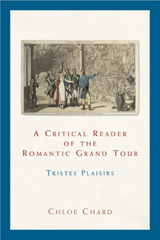Book review: Two books on the Grand Tour
The Grand Tour actually began as a concept rather earlier than is often assumed


Two new books on the Grand Tour reviewed. To buy any of these books at discounted prices you can visit the Country Life Bookshop
The Jacobean Grand Tour Edward Chaney and Timothy Wilks (I.B. Tauris, £25 *£22.50) reviewed by John Ure:
For most of us who are now conversant with gap years, conducted tours, escorted cruises or independent adventuring, the Grand Tour is synonymous with 18th- or early-19th century travel. We think of English milordi setting off for Italy-often accompanied by tutors to focus them on art and architecture rather than on girls and gambling-and returning with rich spoils to adorn the country houses they were shortly to inherit. After all, it was only in 1776 that Dr Samuel Johnson notably remarked that ‘the grand object of travelling is to see the shores of the Mediterranean'.
The theme of this book, written by two erudite dons and largely based on their earlier lectures and articles, emphasises that the Grand Tour was alive and running well before the 18th century. In fact, by the beginning of the 17th century, plenty of young English aristocrats were setting off, not only to France, but to Spain and over the Alps to Italy. These milordi include a Howard de Walden shortly to become Earl of Suffolk, another Howard shortly to become Earl of Arundel and several Cecils, later Earls of Salisbury and Exeter. Even the young Prince Charles-later to become the ill-fated Charles I-discovered his flair for collecting Old Master paintings when on tour in Spain. Tutors and mentors included no lesser figures than the architect Inigo Jones and the diplomat Sir Henry Wotton (best remembered for his remark about ambassadors being honest men sent abroad to lie for their country).
As with the Napoleonic and Nazi periods, the Tudor decade prior to the early 17th century was a time when wars and political or religious conflicts put continental Europe effectively out of bounds to British travellers. It was all the more exciting, therefore, for these Stuart Grand Tourists to explore the alien but civilised lands of a Catholic world in which, for so long, they had been unwelcome. The authors explain how they made the most of these opportunities.
Not only is this book as well researched as one would expect from its scholarly authors, but it is also lavishly illustrated to illuminate the points they make: a dozen colour plates and more than 100 black-and-white drawings and photographs make the reader feel they have been on a grand tour themselves.
A Critical Reader of the Romantic Grand Tour: Tristes Plaisirs Chloe Chard (Manchester University Press, £17.99 *£16.19) reviewed by Clive Aslet
Sign up for the Country Life Newsletter
Exquisite houses, the beauty of Nature, and how to get the most from your life, straight to your inbox.
To call a book about the Grand Tour Tristes Plaisirs shows originality. Usually, the dissipations of the Society of Dilettanti and other milordi are characterised as a rollicking, aristocratic equivalent of a gap year, but the travellers' accounts anthologised in this book show that pleasure seeking could also be a serious affair.
Authors, having walked themselves off their feet around the churches of Rome, are exhausted by the time they reach Naples, thankful that it had little that they deemed worth seeing. Henry Matthews was, admittedly, below par, publishing The Diary of an Invalid in 1820, but captures the general mood in an entry for February 6, 1817: ‘Beautiful day... My spirits are as dark as November.' Henry Sass, a lively and observant Royal Academy student, could not thoroughly enjoy some ‘delicious' ices because of beggars outside the door. The southern climate, although universally regarded as ‘balmy', seemed effeminate. Even the effort to describe the sublimities of Vesuvius or the Coliseum, which, a sentence before, have been called indescribable, has an air of doomed heroism about it. Chloe Chard can make a meal of her analysis. Several paragraphs are devoted to a comment addressed to Matthews in an art gallery, after he has loudly deplored the addition of tin fig-leaves to classical statues: ‘An Italian lady... whispered in my ear,-that I must come again in the Autumn.' No need. We get the point. But what a feast is here. We suffer with Hazlitt as he crosses the Alps, cut by the wind ‘like a scythe'. Our mouths water at the descriptions of food. One only wishes that the people who visited Canova in his studio had managed to write something more interesting about him.
* Subscribe to Country Life and save
* Follow Country Life magazine on Twitter
Country Life is unlike any other magazine: the only glossy weekly on the newsstand and the only magazine that has been guest-edited by HRH The King not once, but twice. It is a celebration of modern rural life and all its diverse joys and pleasures — that was first published in Queen Victoria's Diamond Jubilee year. Our eclectic mixture of witty and informative content — from the most up-to-date property news and commentary and a coveted glimpse inside some of the UK's best houses and gardens, to gardening, the arts and interior design, written by experts in their field — still cannot be found in print or online, anywhere else.
-
 Athena: We need to get serious about saving our museums
Athena: We need to get serious about saving our museumsThe government announced that museums ‘can now apply for £20 million of funding to invest in their future’ last week. But will this be enough?
By Country Life
-
 Six rural properties with space, charm and endless views, as seen in Country Life
Six rural properties with space, charm and endless views, as seen in Country LifeWe take a look at some of the best houses to come to the market via Country Life in the past week.
By Toby Keel